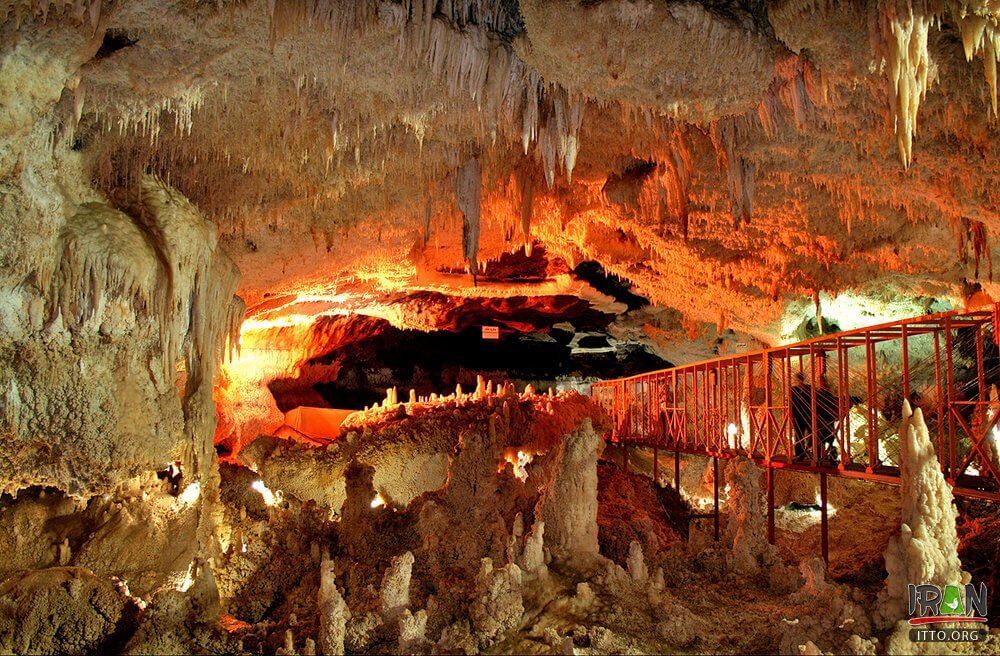Deep in dark: the allure and adventure of Iran caves

TEHRAN – Having a wealth of geological and cultural treasures, caves have always been mysterious and fascinating for adventurers.
Cave tourism is a unique and rewarding form of traveling that allows visitors to discover the hidden wonders of the earth, contribute to the local economy, and support conservation and scientific research.
Some say exploring these underground labyrinths is not only an adventure of a lifetime, but also a way of understanding the Earth's history, biodiversity and human heritage.
One of the most popular destinations for cave enthusiasts is Ali-Sadr Cave, located near the city of Hamadan. It is a gigantic water-filled cavern is believed to date from the Jurassic era. It embraces a huge matrix of sunless channels, ponds, grottoes, and water passages which are stretched along with imposing rock formations and stalactite-covered tops in a span of several kilometers.
The entrance to the lengthy cave is situated some 70km north of Hamadan. Sightseeing there is connected with traversing well-lit labyrinths of waterways via paddle boats, walking on subterranean islets, as well as observing rock carvings of hunting scenes, artifacts, paintings, and vessels that are associated with prehistorical troglodytes.
Another popular destination is Katale-Khor, a limestone cave full of natural crystals believed to date from the Jurassic era, which is located in the northwestern Zanjan province.
Literally meaning “Mountain of the Sun”, the cave is said to date back to some 120 million years ago, so it has embraced lots of natural and artificial changes during this lengthy period. The cave was reportedly discovered some seven decades ago by a group of Iranian cavers.
The interior of the cave includes huge hallways and corridors, impressively illuminated by flashlights. So far, about three-sevenths of the extensive cave have been explored. A length of about 3 km of the cave is open to the public, while a 4 km long path is accessible to experienced cavers and researchers.
Situated on a large cliff, some 40 km from Takab in the western province of Kordestan, the Karaftu Cave ensemble has served as a dwelling since the early Sasanian period (224–651). The enigmatic caves were formed naturally, but have been modified by the inhabitants over the centuries. In ancient times, these caves were important from an economic point of view because they were on the Silk Road.
The Karaftu ensemble is also significant for a Greek inscription found in them, as this is one of the few examples of such a script preserved in situ in Iran.
Quri Qaleh (or Quri Qala Cave) is located in the foothills of the Shaho mountain range, 86 kilometers from the western province of Kermanshah.
The water cave, which is formed some 65 million years ago, is 12 kilometers long and 3,140 meters deep. Being explored for the first time in the 1950s, the cave is one of the longest caves in Western Asia.
There are some historical signs from the Sassanid era (224-651 CE) found in the cave, including silver plates, some pieces of pottery and 15 coins from the Yazdgerd III period. There are also some words in Pahlavi on plates and coins. Moreover, archaeology excavations have revealed that the Quri Qaleh Cave was a hunting lodge during the Stone Age.
Cave tourism in Iran is not just limited to these destinations. Other popular caves include Sarab Cave and Chama Ice Cave, which boast unique features, ranging from stunning underground waterfalls to mesmerizing crystal formations.
The historical cave of Sarab is located in the small town of Baba-Heidar, in the southwest of Kohgiluyeh and Boyer-Ahmad province. The limestone cave is considered one of the most beautiful and original attractions in the region. Entering this cave and trekking through it is a very exciting and challenging task, as it is in a spot with a narrow path that runs parallel to a valley.
Even if you cannot enter the cave, you can enjoy the cold and refreshing water of spring at the entrance of the cave. The cave's small entrance opens into a beautiful corridor with stalactite-covered spikes that look like chandeliers hanging from the ceiling.
One of the most popular destinations for nature travelers in the southwestern province of Chaharmahal-Bakhtiari is the Chama Ice Cave, which despite its natural beauty is very dangerous. Located in the central part of Koorang town, the Ice Cave is a popular place for people who want to escape the heat.
However, ice layers of this cave are a bit thick in the hot season and it is important to avoid crossing them and entering the cave. The Chama Ice Cave is one of the most amazing caves in the province. The location in deep valleys and the accumulation of snow in this cave over the years have meant that the ice caps and huge masses of snow are permanent in every season.
With its diverse and breathtaking landscapes, Iran continues to enthrall visitors with its rich natural beauty. For those looking for an adventurous and unique experience, cave tourism in Iran offers just that.
Iran is geologically part of the Alps-Himalayan natural belt. According to the Britannica Encyclopedia, there is puzzling evidence of human presence on the Iranian Plateau as early as the Lower Paleolithic. The first well-documented evidence of human habitation comes from deposits from several excavated caves and rock shelters located mainly in the Zagros mountains of western Iran, dated to the Middle Paleolithic or Mousterian period (c. 100,000 BC).
AFM
Leave a Comment